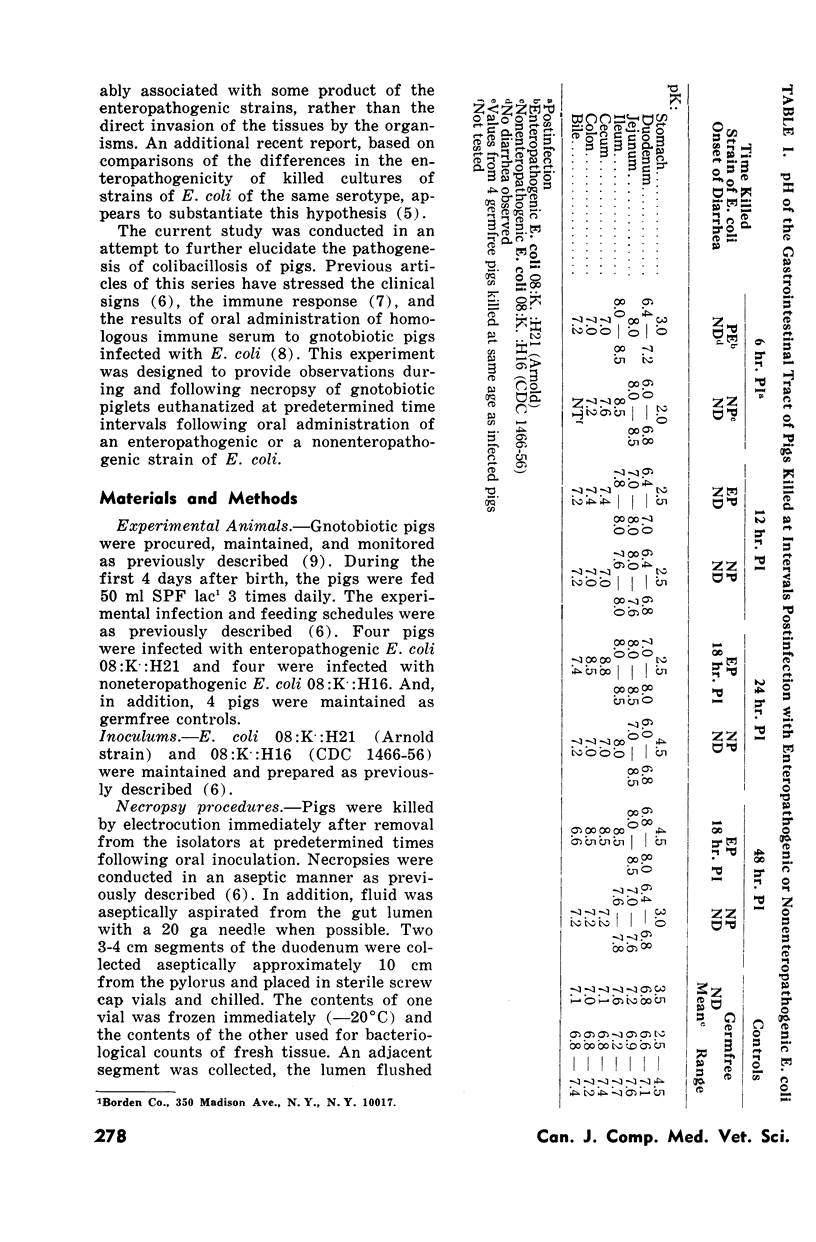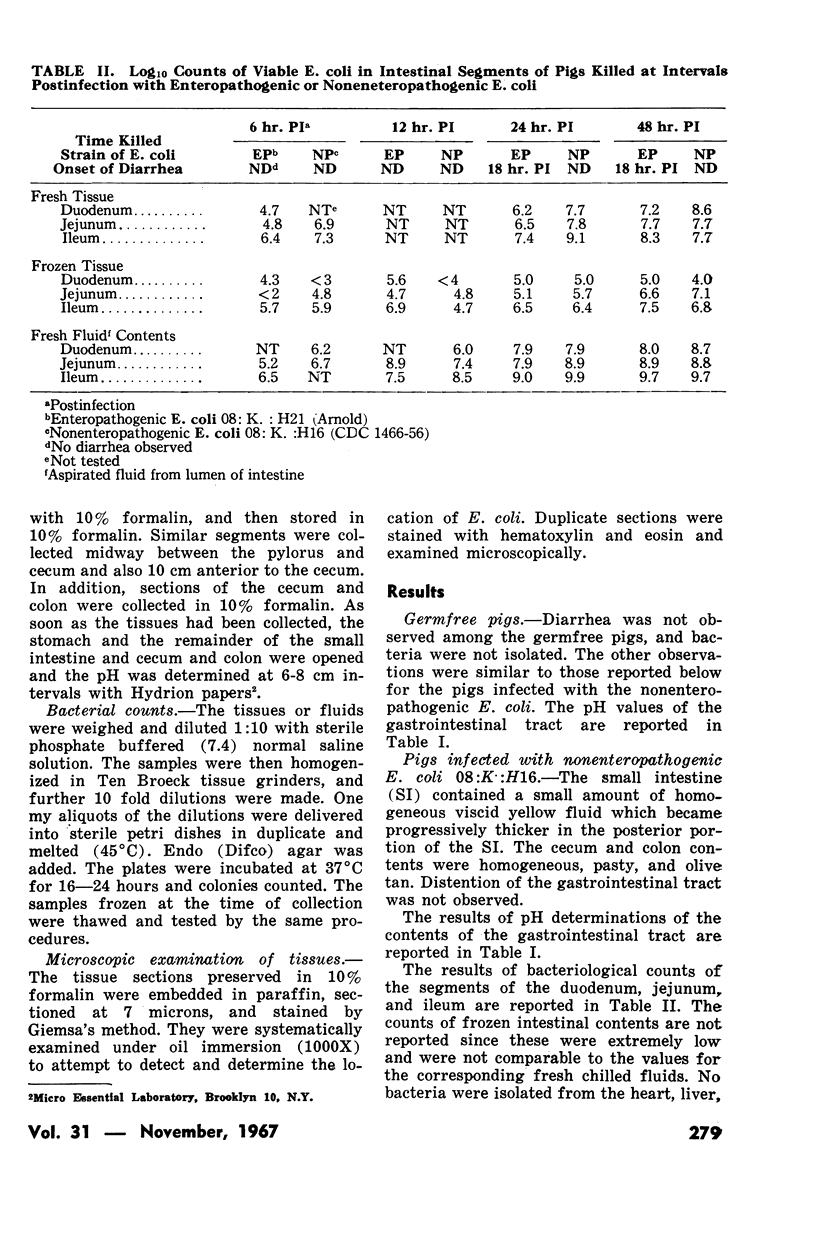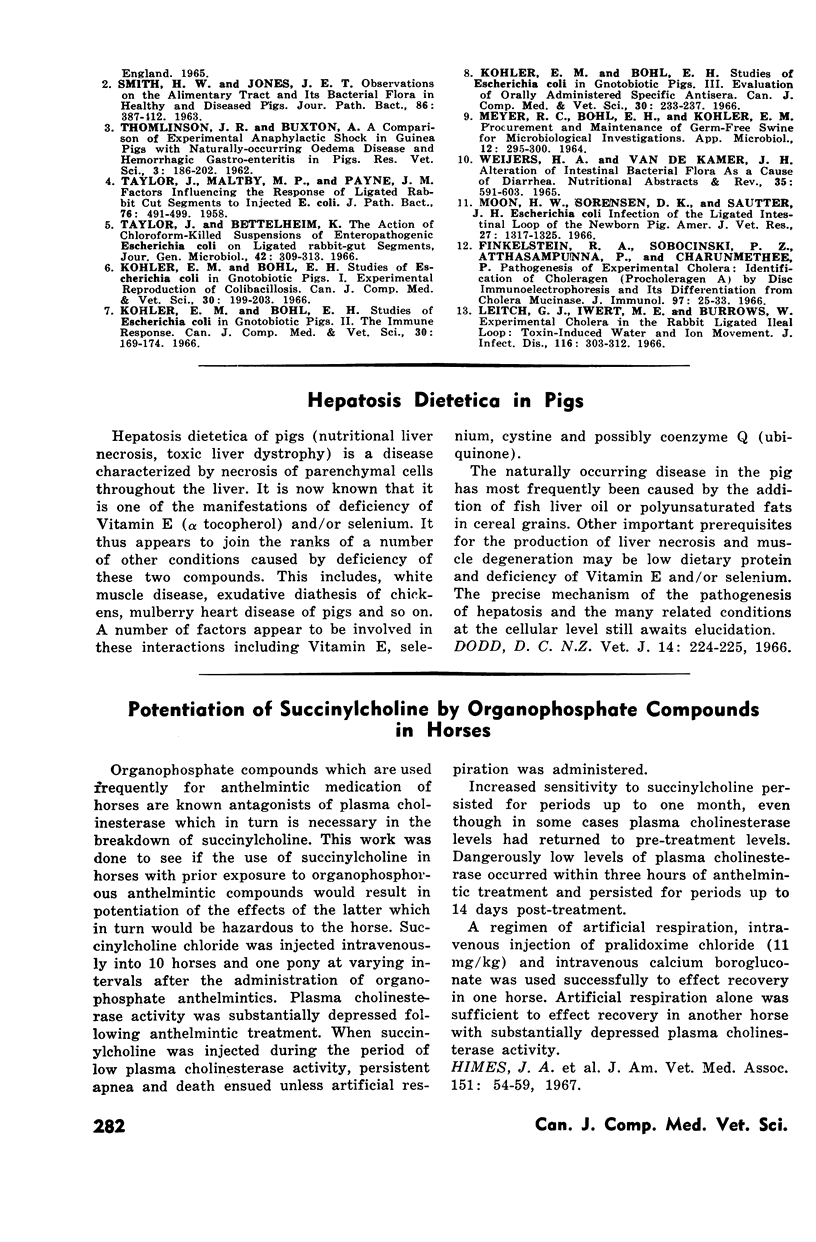Abstract
Four gnotobiotic pigs were infected with an enteropathogenic strain of Escherichia coli, and 4 were infected with a nonenteropathogenic strain of E. coli. Pigs killed in pairs at 6, 12, 24, and 48 hours PI. Four pigs were maintained as germfree controls. The discussions were based on the results of 1) clinical observations, 2) necropsy observations, 3) counts of viable E. coli in segments of the small intestine, 4) attempts to isolate E. coli from the heart, liver, and bile, 5) microscopic examination of fixed intestinal sections to determine the location of E. coli and morphologic evidence of the host response, and (6) determinations of the pH of the contents of the various portions of the gastrointestinal tract.
No diarrhea, fluid accumulation, or impairment of the digestive capacity were noted in the pigs infected with the nonenteropathogenic strain of E. coli. The number of viable E. coli detected in the respective segments of the homogenized small intestine was similar in pigs infected with either strain.
Diarrhea occurred continuously starting 18 hours PI in the pigs infected with the enteropathogenic strain and killed 24 or 48 hours PI. The pH of the contents of the cecum and colon became markedly more alkaline simultaneously with the increase in the heterogeneity and fluid content of the cecum and colon and thus appeared to correlate well with the onset of the clinical diarrhea. No enteritis was detected grossly or microscopically.
The characteristics that determine the enteropathogenicity of a strain of E. coli could not be defined from the results, but it was noted that the host response appeared to be quite similar to that of infant rabbits experimentally infected with Vibrio cholera.
Full text
PDF





Selected References
These references are in PubMed. This may not be the complete list of references from this article.
- Dodd D. C. Hepatosis diaetetica in pigs. N Z Vet J. 1966 Dec;14(12):224–225. doi: 10.1080/00480169.1966.33674. [DOI] [PubMed] [Google Scholar]
- Finkelstein R. A., Sobocinski P. Z., Atthasampunna P., Charunmethee P. Pathogenesis of experimental cholera: identification of choleragen (procholeragen A) by disc immunoelectrophoresis and its differentiation from cholera mucinase. J Immunol. 1966 Jul;97(1):25–33. [PubMed] [Google Scholar]
- Himes J. A., Edds G. T., Kirkham W. W., Neal F. C. Potentiation of succinylcholine by organophosphate compounds in horses. J Am Vet Med Assoc. 1967 Jul 1;151(1):54–59. [PubMed] [Google Scholar]
- Kohler E. M., Bohl E. H. Studies of Escherichia coli in gnotobiotic pigs 3. Evaluation of orally administered specific antisera. Can J Comp Med Vet Sci. 1966 Aug;30(8):233–237. [PMC free article] [PubMed] [Google Scholar]
- Kohler E. M., Bohl E. H. Studies of Escherichia coli in gnotobiotic pigs. I. Experimental reproduction of colibacillosis. Can J Comp Med Vet Sci. 1966 Jul;30(7):199–203. [PMC free article] [PubMed] [Google Scholar]
- Kohler E. M., Bohl E. H. Studies of escherichia coli in gnotobiotic pigs. II. The immune response. Can J Comp Med Vet Sci. 1966 Jun;30(6):169–174. [PMC free article] [PubMed] [Google Scholar]
- Leitch G. J., Iwert M. E., Burrows W. Experimental cholera in the rabbit ligated ileal loop: toxin-induced water and ion movement. J Infect Dis. 1966 Jun;116(3):303–312. doi: 10.1093/infdis/116.3.303. [DOI] [PubMed] [Google Scholar]
- MEYER R. C., BOHL E. H., KOHLER E. M. PROCUREMENT AND MAINTENANCE OF GERM-FREE SEINE FOR MICROBIOLOGICAL INVESTIGATIONS. Appl Microbiol. 1964 Jul;12:295–300. doi: 10.1128/am.12.4.295-300.1964. [DOI] [PMC free article] [PubMed] [Google Scholar]
- SMITH H. W., JONES J. E. OBSERVATIONS ON THE ALIMENTARY TRACT AND ITS BACTERIAL FLORA IN HEALTHY AND DISEASED PIGS. J Pathol Bacteriol. 1963 Oct;86:387–412. [PubMed] [Google Scholar]
- TAYLOR J., MALTBY M. P., PAYNE J. M. Factors influencing the response of ligated rabbit-gut segments to injected Escherichia coli. J Pathol Bacteriol. 1958 Oct;76(2):491–499. doi: 10.1002/path.1700760218. [DOI] [PubMed] [Google Scholar]
- Taylor J., Bettelheim K. A. The action of chloroform-killed suspensions of enteropathogenic Escherichia coli on ligated rabbit-gut segments. J Gen Microbiol. 1966 Feb;42(2):309–313. doi: 10.1099/00221287-42-2-309. [DOI] [PubMed] [Google Scholar]
- Weijers H. A., van de Kamer J. H. Alteration of intestinal bacterial flora as a cause of diarrhoea. Nutr Abstr Rev. 1965 Jul;35(3):591–604. [PubMed] [Google Scholar]


